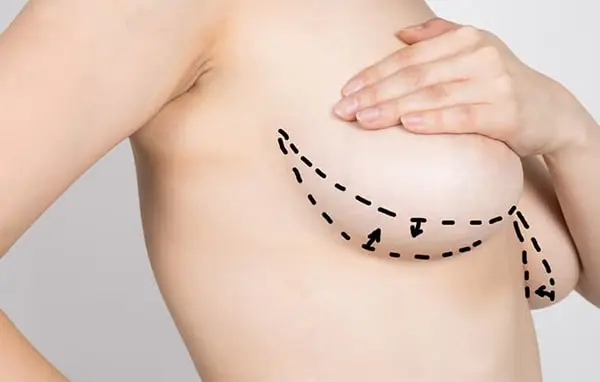Asymmetric Breasts: Should You Worry?
It's perfectly natural for breasts not to be perfectly symmetrical. Breast asymmetry is common in many women and shouldn't be a cause for concern. Even with a noticeable difference in breast size or shape, solutions exist to address this asymmetry. Cosmetic and plastic surgery offer effective techniques to correct these imperfections. Whether through breast implants, lipofilling, or other customized procedures, surgical options can help restore balance and achieve satisfactory aesthetic results. By consulting an experienced plastic surgeon, you can discuss the various possibilities and decide on the treatment best suited to your individual needs.
Asymmetric Breasts: What is it?
Breast asymmetry is a common characteristic in most women. Our bodies aren't designed to be perfectly symmetrical, and this reality also applies to our breasts. Differences between the right and left side can vary in subtlety: sometimes barely perceptible, sometimes more pronounced and obvious. Breast asymmetries can take different forms: a difference in size, where one breast is larger than the other; an asymmetry of shape, where breasts may have different shapes from one side to the other; an asymmetry of position, where one breast appears to be shifted relative to the other; or even an asymmetry of nipples or areolas, which may have different orientations between the two sides. These variations are perfectly normal and should generally not be a cause for concern. However, if breast asymmetry bothers you, treatment options exist, including cosmetic surgery, to correct these differences and restore a more balanced and satisfactory appearance.
EXPRESS QUOTE
Would you like more information?
Your health, our priority.
Request your free quote
Causes of Breast Asymmetry
Variations in breast asymmetry can generally be grouped into:
Congenital Breast Asymmetry
Breast asymmetry can result from various causes, including genetic, hormonal, or developmental factors. In some cases, breast asymmetry can be congenital, meaning it is present from birth. This condition may be due to uneven development of the mammary glands during puberty or natural variations in the composition of breast tissue. In some women, breast asymmetry can also develop as a result of hormonal changes, such as those observed during pregnancy or breastfeeding. Although breast asymmetry is generally medically harmless, it can sometimes cause psychological discomfort due to its impact on physical appearance. Fortunately, treatment options exist, including plastic surgery, that can help correct breast asymmetry and restore aesthetic balance.
Acquired Breast Asymmetry
Acquired breast asymmetry can result from various causes, including physical trauma, surgical interventions, or medical treatments such as radiotherapy as part of cancer therapies. Sometimes, it can occur following major physiological changes such as pregnancy and breastfeeding, where weight fluctuations and hormonal changes can significantly affect breast size and shape. Additionally, the simple passage of time can contribute to tissue failure, leading to visible asymmetry. In rarer cases, medical conditions such as Poland syndrome, scoliosis, or scleroderma can also be associated with breast asymmetry. These factors can impact self-esteem and psychological well-being, but treatment options exist, including plastic surgery, to correct these differences and restore breast symmetry.
Asymmetric Breasts: What Treatments?
Because of the psychological and social challenges that significant breast asymmetry can cause for a woman, various cosmetic surgery procedures offer solutions to treat this imperfection. Among these options are:
- Breast augmentation, which aims to increase the size of the asymmetric breast to achieve balance with the other breast.
- Breast reduction, which involves reducing the size of the larger breast to create symmetry with the other breast.
- Mastopexy, also known as a breast lift, which reshapes and repositions the breasts to correct sagging and improve their shape and symmetry.
These procedures, performed by qualified plastic surgeons, can help restore self-confidence and improve the quality of life for women concerned about significant breast asymmetry.
Breast Augmentation
Breast augmentation is a cosmetic surgical procedure that aims to increase the size and improve the shape of the breasts. This procedure is often chosen by women who wish to increase the volume of their breasts, correct breast asymmetry, or restore fullness lost after pregnancy or significant weight loss. Breast augmentation can be performed using silicone or saline breast implants, which are carefully selected based on the patient's preferences and the recommendations of the plastic surgeon. These implants are inserted either behind the pectoral muscle or directly behind the breast tissue, to create a natural and harmonious result. In some cases, an alternative to implantation is breast lipofilling, a technique that uses fat harvested from other parts of the patient's body to increase breast volume naturally. Before undergoing breast augmentation, it is important to consult a qualified plastic surgeon to discuss expectations, risks, and available treatment options.

Breast Reduction Surgery
Unlike breast augmentation, which aims to increase breast volume, breast reduction surgery aims to decrease the volume of one breast relative to the other. This procedure is ideal for adjusting breast volume and shape, especially if the patient does not wish to increase the size of the smaller breast. Breast reduction involves the excision of excess glandular and adipose tissue, as well as the restructuring of the breast contours to obtain a more proportionate and aesthetic appearance. After the operation, a mastopexy, or breast lift, can also be performed to prevent any loss of neckline firmness. This step involves lifting and recentralizing the remaining mammary gland, while removing excess skin to obtain firm and shapely breasts.

Mastopexy
Mastopexy, also known as a breast lift, is a surgical procedure chosen by patients who wish to restore the firmness and youthful appearance of their breasts. Unlike breast augmentation, mastopexy may not require the use of breast implants, focusing instead on the restructuring of existing tissues. This cosmetic surgery procedure usually begins with incisions around the areola and nipples, allowing the surgeon to deeply reshape the breast, restore its tone, and lift it to correct skin laxity. The main objective of mastopexy is to treat breast ptosis, also known as breast sagging. In addition to restoring youthfulness and firmness to the breasts, this procedure can also be used to correct breast asymmetry and can be combined with a mastoplasty for augmentation or reduction depending on the patient's specific needs.
